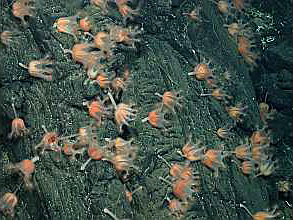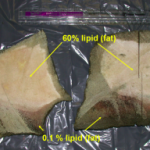
A recently-discovered jellyfish has been found at newly discovered vents in the Pacific Ocean. Credit: WHOI
Last week while DSN focused on charismatic megafauna with notochords, a newly discovered species without pharyngeal slits at a newly discovered vent field was uncovered at 8500 feet during the expedition discussed by Kevin. The new species is from the Cnidarian (phylum of jellyfish, corals, anemones) order stauromedusae. The jellyfish’s resemblance to Medusa lends itself to the new vent’s name. The new species is unusual in its color (pink) and its proximity to to the superheated vent fluids.






Hooray! It is always great to see Stauromedusae written about. I would, however, caution against accepting the assertion that these beautiful specimens represent a new species, especially based on conjectures of color differences. Anybody else think these “pink” critters look a bit orange? Shallow water Stauromedusae are notoriously variable in color.
Not too long ago, Meg Daly and I published a description of a new species of Stauromedusae from not too far away on the EPR (Collins AG & M Daly. 2005. A new deepwater species of Stauromedusae, Lucernaria janetae (Cnidaria, Staurozoa, Lucernariidae), and a preliminary investigation of stauromedusan phylogeny based on nuclear and mitochondrial rDNA data. Biological Bulletin 208: 221-230).
If you look closely at the awesome picture (http://www.nsf.gov/news/mmg/media/images/stauromedusae_h.jpg), you see that the color is coming from very ripe gonads and that the rest of the animals, and a few juveniles tucked among the adults, are pretty much transparent. This color variation (clear to orange) was noted even more recently in an excellent little paper by Janet Voight (Stauromedusae on the East Pacific Rise. Cah. Biol. Mar. (2006) 47 : 347-352), after whom Meg and I named the species referred to above.
I and others have also reported (unfortunately VERY limited) data from other populations of Stauromedusae widely distributed on the EPR (Stauromedusan populations inhabiting deep-sea hydrothermal vents along the southern East Pacific Rise. Cah. Biol. Mar. (2006) 47 : 409-413). These data show surprisingly low levels of genetic divergence, suggesting that at least some deep sea Stauromedusae species may have large ranges.
While we obviously suffer from not knowing a lot about the deep sea, I would bet a fair amount that the Stauromedusae from the newly discovered medusa vent is Lucernaria janetae.
Cheers,
–Allen
Allen, thanks for the extra information.
I was on the expedition in 2003 when Meg collected these critters. They are really cool and I cannot overstate enough the density at which we found these beasties! These stauromedusae from the south EPR look exactly like the ones we found at 8N on the northern EPR. I’m not sure but I believe ones we observed and collected didn’t have much gonad at the time of collection, so it may be we missed the orangish color due to seasonal reproduction etc. Or it may be a population level characteristic.
In some photos from the 2003 expedition, a few individuals had an orangish tint to them, but the obvious orange patterning of the gonad seen in the above picture.
Stay tuned tommorrow for more on this deep-sea stauromedusan!